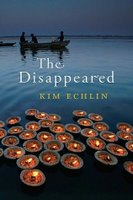The Disappeared
 A brand new novel by Kim Echlin has this month been published in Canada. It's called The Disappeared and tells the story of love between a Canadian girl and a Cambodian student who returns to his country, never to be seen again. That forces the heroine to go in search of her lost love and to discover the truth behind the country of his birth. For Echlin, this is her third novel, as well as having experience as an arts documentary producer and writer for various publications.
A brand new novel by Kim Echlin has this month been published in Canada. It's called The Disappeared and tells the story of love between a Canadian girl and a Cambodian student who returns to his country, never to be seen again. That forces the heroine to go in search of her lost love and to discover the truth behind the country of his birth. For Echlin, this is her third novel, as well as having experience as an arts documentary producer and writer for various publications.The following is an excerpt from the book, copyrighted to the author and Hamish Hamilton Canada.
The torturers of Tuol Sleng complained of working long hours, of fatigue. They confessed that it was difficult to prevent themselves from killing in a temper. But they did not complain of the violence. They said, If we did not kill, we would be killed.
You did not want to come with me to Tuol Sleng, Street 103, the hill of the poison tree.
I said, If you do not come I am going anyway. But I want you to come with me.
You said, No use.
Borng samlanh, come. I want to know what you know.
I put my arms around you and you let me and you said, You smell so good.
Tuol Sleng is raw.
It is easy to imagine this place transformed from museum back to extermination center in an hour. Everything left as it was. Burned walls. Bloodstained floors. Metal bed frames and shackles and electrical wires. A barrel of water to submerge a head. People walk over the courtyard graves before they know what they are walking on. There are hand-drawn signs, concrete block rooms, walls of photographs and glass cases of skulls. Paintings of the tortures, fingernails pulled out, men lying in rows on the classroom floors, shackled at the ankles, prisoners beaten and left in tiny cells. The eyes of those whose names disappeared stare from the walls. Their spirits are unprayed for because any family that might have prayed for them is dead.
Five thousand photographs of the dead of Tuol Sleng. Each picture refuses anonymity. Boy number 17. He has no shirt and they have safety-pinned his number into his skin. A small woman with the number 17-5-78 pinned on her black shirt stares into the camera and at the bottom of the photo a child’s small hand clings to her right sleeve.
Grief changes shape but it does not end.
It was a hot day and your forehead was damp. You said, When I first got back I came here to see if I could find pictures of anyone I knew. Tien’s whole family disappeared. I never found anyone who knows what happened to them. In the first months people wrote the names of those they recognized on the pictures. I found no picture to write on.
In Tuol Sleng a person is asked to stare. A person is asked to imagine clubbing someone to death, imagine attaching wires to genitalia, pulling a baby by the ankles away from its screaming mother and smashing its head against a tree.
I was numbed by this vision of a human being. I stood beside you and you were so far away that I could not touch you.
In Tuol Sleng a person can be torturer or tortured, a person can imagine a Pure system.
The Khmer Rouge said, Better to kill the innocent than to leave one traitor alive. This is the heart of Purity.
When I was writing this, I dreamed an old woman came to me and said, Help me to see into the darkness. In the dream I protested, How?
See the child. She has a strong jaw, but her eyes are a child’s eyes. Look into the pupils of her eyes. This is a body made vulnerable. This girl is available to wound. She does not even wear a number. She was not even worth a number. This is war. This is the darkness. This child too was murdered in Tuol Sleng.
Labels: Kim Echlin, The Disappeared

